By Steven Smith
Possession of the ball is an essential element for game domination. However, in the modern game a team can possess the ball for long periods of time or a majority of the game and not be successful in winning the game. The team must be effective in their possession and it must result in good scoring opportunities. Therefore, teams must be trained to possess in the front third of the field and create good scoring movement and opportunity. This session is one of a series of three training sessions which progressively become more demanding and helpful in creating front third opportunities.
Lesson 1: Warm-up: Three Squares
Set up: This activity emphasizes connecting passes while under controlled pressure (level of pressure controlled by coach). The athletes will need to move to position themselves for connecting passes by short movements. This movement and communication necessary under strict pressure of time and space can have a great effect on connecting passes in game settings. The first activity is set up as below:
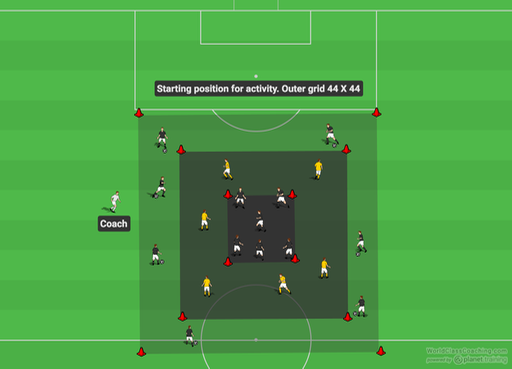
Execution:
Two groups of six to seven players occupy three grids one inside the next (see graphic below). The idea is for the group on the outermost grid to connect passes to the group on the innermost grid. Start off with each of the outer players possessing a ball to attempt to pass into the center grid. The middle grid is occupied by defenders who cannot leave their grid but works to intercept passes that come through their grid.
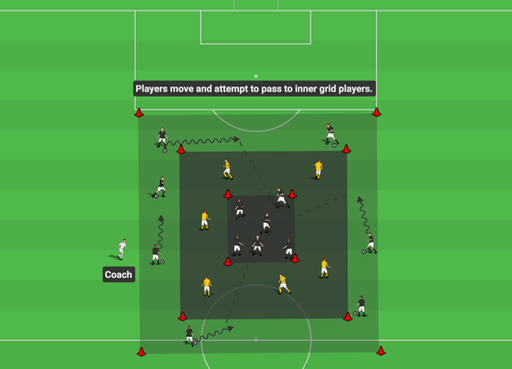
The focus is on the outer grid group of players for feedback from the coach. Their movement around their grid is essential for finding the line of passing that will enable them to connect with the inner grid. This means the coach can give feedback on keeping the head up, keeping the ball moving and looking for opportunities. The key cues essential for connecting passes of posture, eye contact and verbal communication are essential as well and the coach can focus on those cues. Players rotate grid locations with their group after a time limit or after all of the starting balls have been knocked out of the grids by the defending group.
Variations:
Add goalkeepers to the inner group for receiving with their hands.
Add goalkeepers to the middle defensive group who can use their hands to intercept passes (increases difficulty for the outside group).
Add competition with consequences for the losing groups by counting the number of completed passes before their balls are knocked out by the defending group.
Reintroduce balls knocked out and play for time only and count completed passes. As balls are knocked out of play by the middle group the players on the outside grid can combine passes together before attempting to pass the ball to the inner grid.
Players may attempt to dribble through the middle grid and a player in the inner grid must then switch places with the dribbler on outside grid.
Lesson Two: Technical Drill: Twenty One (Blackjack):
Setup: Possession oriented play is essential to the modern game of soccer. Many of the activities to develop possession allow for maximum success by giving space for possession or by giving extra attackers to the possessing side. The ability to control the ball in possession in tight spaces is often ignored in training session by prioritizing success and space.
This activity emphasizes possession while having to concentrate and think more than just one step ahead. The athletes will need to move to position themselves for maintaining possession in very tight spaces (much like the full sided game when compressed to a certain portion of the field). This movement and communication necessary under strict pressure of time and space can have a great effect on maintaining possession once the game whistle blows.
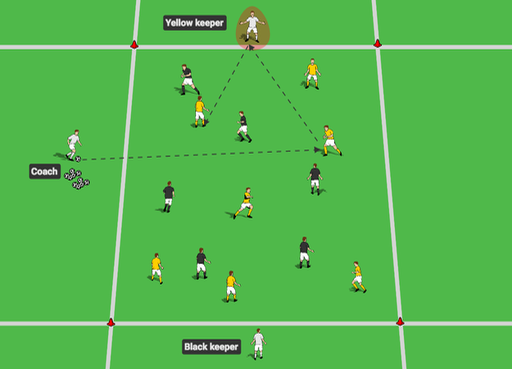
Two teams of seven players occupy a rectangular grid in any portion of the field. Coach serves the ball to either color team for initial play. Each successful pass is counted in sequence until the score of 21 is achieved. Every ball that goes out of play is left out and the coach starts a new ball without hesitation to the team who did not knock the ball out of bounds. Quick transition to the new ball is essential. Once a total (not sequential) 21 passes is achieved the game ends and the losing side must respond with a consequence such as a series of sideline to sideline sprints and the game resumes. A third team waiting in the wings can substitute for the losing side and begin possession by being served the first ball.
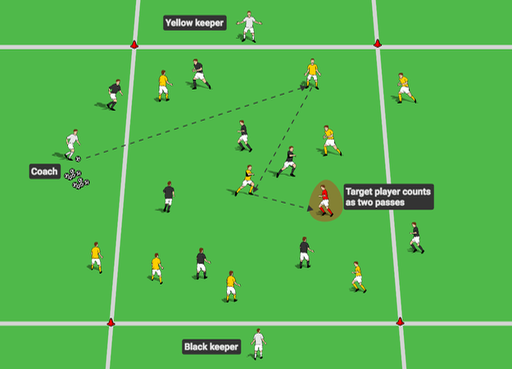
Variations:
Add goalkeepers to the end who can play the ball with either their feet or to the hands (coach's preference) but the pass to the goalkeeper does not count as part of the total completed passes toward the accumulation of 21 passes (see drawing 2).
Lesson Three: Double Goal Possession
Setup: This activity is designed to convert possession to shooting in a quick sequence. The teams must focus on proper and skillful possession of the ball in a tight space and then quickly convert that to a shooting opportunity and apply good finishing skills. Tight spaces are essential for developing this skill in this series. It should also be set up as a functional drill in the portion of the field where the activity would take place in a game setting. This means setting it up in front of the 18-yard box is essential.
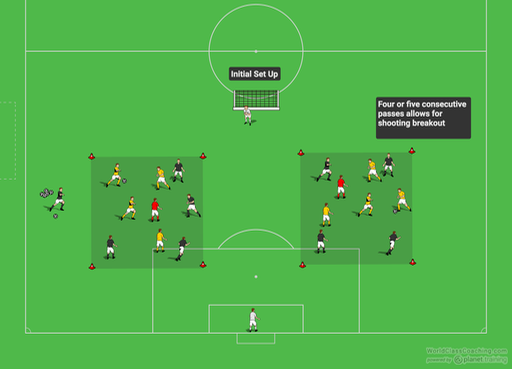
Execution:
Two grids are set up in 18 yard squares approximately 20 yards apart. Two color groups are set up so that each grid has 4 vs. 4 plus 1 in each grid. Each grid plays keep away with the extra color player in red always on the attacking team side (team in possession of ball at any given time). The coach predetermines the number of passes that must be completed consecutively and uninterrupted by anyone on the opposing team before the final player leaves the grid and takes a shot on goal. A player from the sideline joins each grid after a player leaves to shoot. The shooting player rejoins the sideline of the next grid over and the same activity continues.
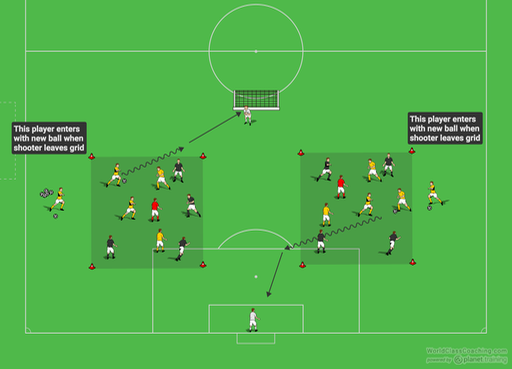
Variations:
All players who take shots return to their same grid they left and score is kept between the two teams in that grid. Winners advance to play winners of the other grid.
Both teams shoot at the same time on opposite goals by the coach blowing a whistle during the possession. The team that scores first on each whistle gets the goal and the second shooter does not get a point even if he or she successfully scores their shot.
By Steven Smith Head Coach at Hope College, Holland, MI


